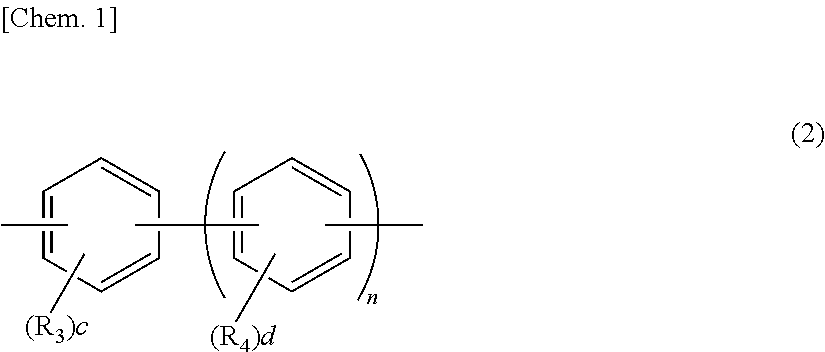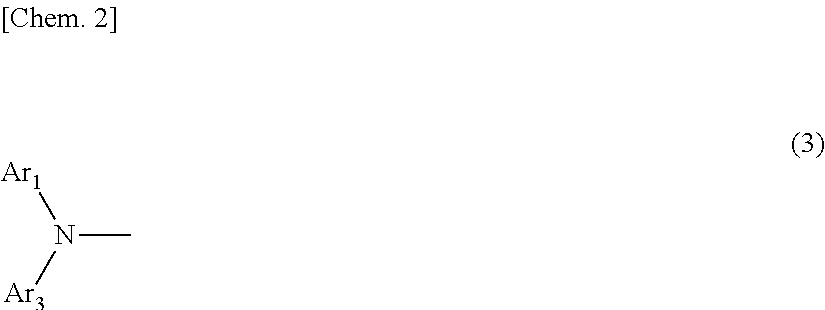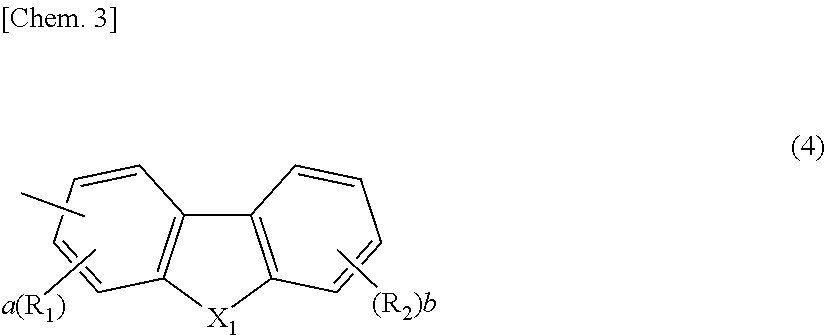Aromatic amine derivative, and organic electroluminescent element comprising same
a technology of organic electroluminescent elements and amine derivatives, which is applied in the direction of luminescent compositions, organic chemistry, chemistry apparatuses and processes, etc., can solve the problems of increasing driving voltage, reducing emission efficiency, and changing luminescent color, so as to achieve high luminous efficiency and hardly deterioration, and long life
- Summary
- Abstract
- Description
- Claims
- Application Information
AI Technical Summary
Benefits of technology
Problems solved by technology
Method used
Image
Examples
synthesis example 1
Synthesis of Intermediate 1
[0306]In a stream of argon, 47 g of 4-bromobiphenyl, 23 g of iodine, 9.4 g of periodic acid dihydrate, 42 mL of water, 360 mL of acetic acid, and 11 mL of sulfuric acid were loaded into a 1,000-mL three-necked flask, and the mixture was stirred at 65° C. for 30 minutes and was then subjected to a reaction at 90° C. for 6 hours. The reactant was poured into ice water, followed by filtering. The resultant was washed with water, and then washed with methanol, whereby 67 g of a white powder were obtained. Main peaks having ratios m / z of 358 and 360 were obtained with respect to C12H8BrI=359 by a field desorption mass spectrometry (hereinafter, referred to as FD-MS) analysis, so the powder was identified as the intermediate 1.
synthesis example 2
Synthesis of Intermediate 2
[0307]In a stream of argon, 10 g of di-4-biphenylylamine, 9.7 g of 4,4′-dibromobiphenyl, 3 g of t-butoxysodium, 0.5 g of bis(triphenylphosphine)palladium (II) chloride, and 500 mL of xylene were loaded, and then the mixture was reacted at 130° C. for 24 hours.
[0308]After the resultant had been cooled, 1,000 mL of water were added to the resultant, and then the mixture was filtered through celite. The filtrate was extracted with toluene and dried with anhydrous magnesium sulfate. The dried product was concentrated under reduced pressure, and then the resultant coarse product was subjected to column purification and recrystallized with toluene. The recrystallized product was taken by filtration, and was then dried. Thus, 9.1 g of a white powder were obtained. The white powder was identified as the intermediate 2 by FD-MS analysis.
synthesis example 3
Synthesis of Intermediate 3
[0309]Under an argon atmosphere, 600 mL of tetrahydrofuran anhydrous were added to 78.0 g of dibenzofuran, and then the mixture was cooled to −30° C. 300 mL of a solution of n-butyllithium in hexane (1.65 M) were dropped to the mixture, and then the temperature of the resultant mixture was increased to room temperature over 1 hour while the mixture was stirred. After having been stirred at room temperature for 5 hours, the mixture was cooled to −60° C., and then 60 mL of 1,2-dibromoethane were dropped to the mixture over 1 hour.
[0310]After having been stirred at room temperature for 15 hours, the resultant mixture was poured into 1,000 mL of ice water, and then the organic layer was extracted with dichloromethane. After having been washed with a saturated salt solution, the organic layer was dried with anhydrous magnesium sulfate, separated by filtration, and then concentrated. The resultant solid was purified by silica gel chromatography (toluene), washed...
PUM
 Login to View More
Login to View More Abstract
Description
Claims
Application Information
 Login to View More
Login to View More - R&D
- Intellectual Property
- Life Sciences
- Materials
- Tech Scout
- Unparalleled Data Quality
- Higher Quality Content
- 60% Fewer Hallucinations
Browse by: Latest US Patents, China's latest patents, Technical Efficacy Thesaurus, Application Domain, Technology Topic, Popular Technical Reports.
© 2025 PatSnap. All rights reserved.Legal|Privacy policy|Modern Slavery Act Transparency Statement|Sitemap|About US| Contact US: help@patsnap.com



